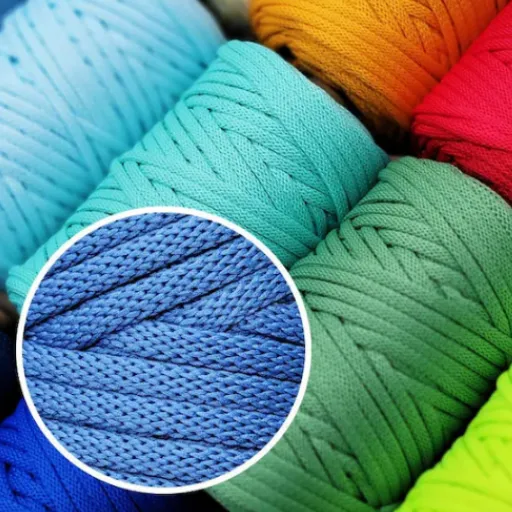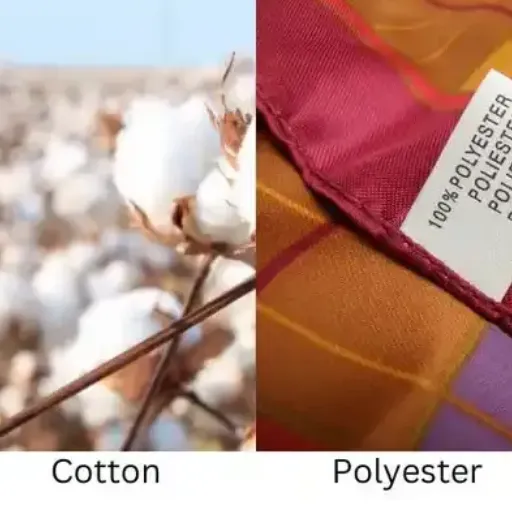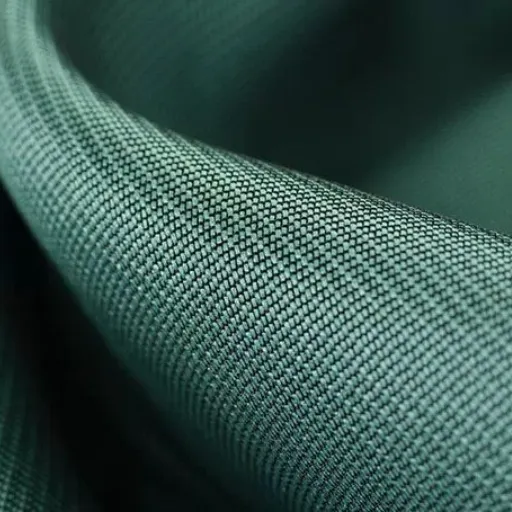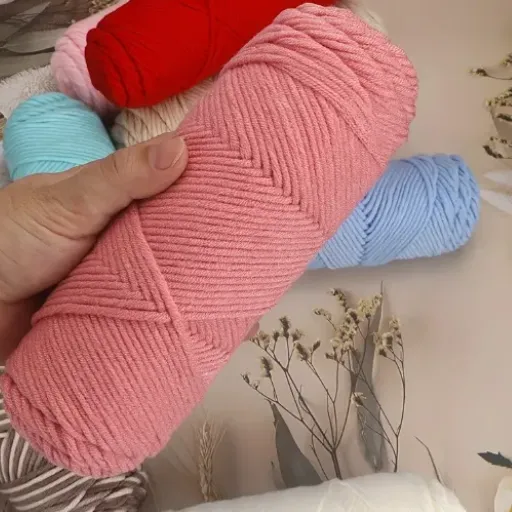For decades, the question of polyester versus cotton has been asked in the selection of fabrics. Each type exhibits her own properties catering to different needs, tastes, and ways of life. From everyday wear to activewear to luxurious bed linen, understanding the crux of how these fabrics differ can help in making better buying decisions. This guide will take a look at the two textiles, considering their characteristics, advantages, drawbacks, and best use scenarios. By the time you wind through the array of fabrics presented, you will surely be able to consider fabric with which to go.
Introduction to Polyester and Cotton
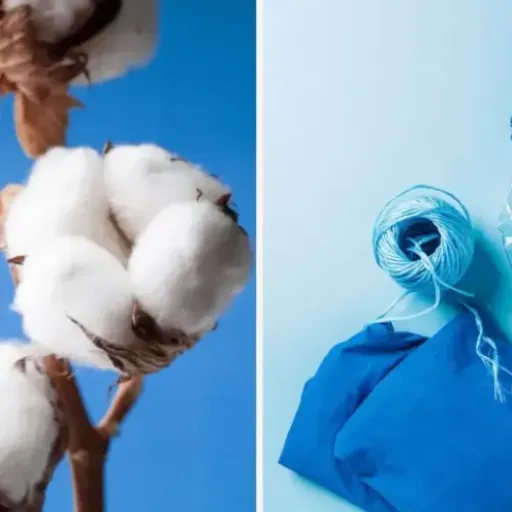
What Is Polyester Fabric And Fiber?
Polyester fabric, being a synthetic material, is made with polymers derived from petroleum, especially polyethylene terephthalate (PET). Formed through a chemical reaction called polymerization, making it polymerized for durability, lightness, and versatility. Its fibers are sturdy, resist stretching or shrinking, and dry fast, so they’re highly favored in the trade.
Being a key characteristic of polyester, it resists wrinkles so that the garments or any other product can maintain a neat appearance without aid from ironing. It is also water and stain-resistant, making it well-suited for the construction of outdoor and active wear. Polyester can also be blended with natural fibers like cotton so that these fabric combinations offer the best of both worlds- the interior comfort of the cotton with the durability of polyester.
Polyester may be cheap and easy to maintain; however, there’s a question mark over its environmental credentials since it is non-biodegradable. On the recycling front, it’s possible with the latest technologies to make recycled polyesters using materials like plastic bottles, thus making the production process more in line with sustainability. This is exactly what made polyester so popular and widely accepted in different industries, ranging from fashion to furnishings.
What Is Cotton Fabric?
Cotton fabric is a natural textile made from the fibers of the cotton plant. These fibers are picked; after which, they are spun into yarn and either woven or knitted into a relatively soft and breathable material. Considered highly versatile, cotton fabric finds applications in almost everything, from clothing to home furnishing and industrial products.
Cotton is easily one of the most comfortable clothes to wear because of its breathable nature. It is very absorbent and absorbs moisture, thereby keeping it away from the body, especially in warm climates. It is also hypoallergenic in nature and hence good for people with sensitive skin. Because of its naturalness, cotton tends to be durable so that cotton fabrics can be washed and worn frequently.
Cotton is said to be a renewable resource; yet, the different steps in the cultivation and production processes bring with them environmental consequences, like water use and pesticide application. Some of such measures to address these concerns include organic cotton production and other sustainable agricultural options. These choices aim to lessen the environmental impacts while still preserving the functionality and quality for which cotton is highly known.
Importance of Knowing Fabric Differences
Know-how regarding the differences of the fabrics is necessary when one wants to make a suitable decision about selecting a material for a certain purpose. The fibers differ with respect to durability, comfort, environmental impact, and care requirements, all of which can affect usage and hence longevity of any object. Natural fibers provide breathability and comfort; hence they make the finest options for clothing. Meanwhile, synthetic fibers provide durability and resistance against environmental factors, thus making them ideal for any outdoor or heavy-use applications.
Actually, from another consideration, it is foremost to understand variations in fabric whenever we study its environmental impact. Some materials differ depending on their production methods or resource consumption and thus have a larger environmental footprint. Fabric types or varieties such as organic cotton or linen are considered more ecological in the sense that they are biodegradable and are grown with less water and chemicals. Contrary to the natural ones, the synthetic varieties are petroleum-based and might create a microplastic pollution scenario. If one recognizes these differences, then they can be better able to make choices that are in keeping with their values and prerequisites for sustainability.
Finally, understanding fabric differences helps in their maintenance and care so that pieces may last longer and perform well with time. Certain fabrics might need peculiar washing methods or treatment to retain their integrity. Silk would require delicate care, for example, but polyester can often be subjected to much rougher cleaning. For the ordinary person, awareness of these measures might serve them well in protecting their investment in fabric-based product purchases while simultaneously helping cut down on waste due to the extended life of garments and articles.
Properties of Polyester Fabric
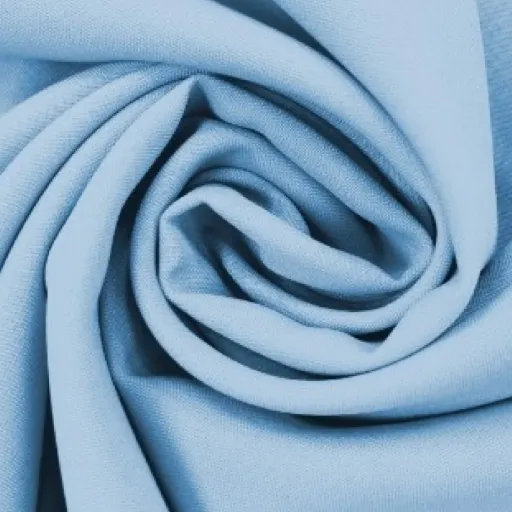
Strength and Durability
Polyester fabric is typically considered to be one of the most durable and strong fabrics, thereby putting it in a preferred position across many industries. This is a synthetic material that will resist stretching, shrinking, or abrasion in order to maintain its shape or integrity through time. Its densely woven fibers make it an extremely durable fabric under frequent use or heavy-duty washing.
Another great merit of polyester under adverse conditions is its ability not to wilt or fade. It performs well in any weather conditions since it will not fade under the radiant sunlight. The chemical resistance and mildew-resistant characteristics of polyester make it even more suitable for challenging applications such as sportswear, upholstery, and industrial textiles.
Apart from physical toughness, polyester has tensile strength, so it is considered a reliable fabric for heavy-duty applications. Whether preventing the possibility of dirt entering a furnace in thermal applications or preventing the fabric from hitting an unstable heavy weight in a piece of clothing or home decor upholstery, polyester has provided the utmost consistency and reliability. These qualities remain among the most desirable properties of making polyester one of the most versatile and durable fabric options today.
Water Resistance and Dryness
Because of its water resistance and rapid drying quality, it has been the preferred fiber for several applications. The fibers in polyester are hydrophobic; they repel water rather than absorb it. That is why polyester fabrics resist moisture penetration and retain their lightweight and durable properties if immersed or exposed to water.
Drying time for polyester is shorter than for many other fabrics. Since it hardly absorbs any water, the drying time is much less than cotton when it gets wet – a very desirable attribute for activewear, outdoor gear, and household items such as curtains. This fast drying helps prevent mold or mildew formation, thus widening polyester’s applications.
Aside from this, its waterproof qualities allow for easy maintenance. It is usual for spills to bead up on the surface of the fabric and wipe away without staining. Hence, polyester is the most dependable fiber for places where moisture management and ease of care are important because of these characteristics, alongside its durability and affordability.
Wrinkle Resistance and Care Requirements
Polyester is considered for its wrinkle resistance; hence they are selected for garments and upholstery that are easy to maintain. The property is that the synthetic fibers retain any original shape or configuration of the crease, even after being used for a long time or being folded for hours. In a way opposite to how nature takes effect on other fabrics, polyesters have an advantage by not requiring repeated ironing while saving plenty of time and energy during care routines.
Caring for polyester is a great example of simplicity, which adds to its great appeal. The fabric can be thrown into a machine, washed, then dried on low to medium heat. Should you want to keep the cloth in good condition, avoid dyeing it with high heat as that eats at the strength of the fibers with time. Apart from resisting shrinkage and stretch, polyester also keeps items in fit form after repeated washes.
Great maintenance would only spot-clean minor spills with mild detergents, thereby somewhat extending the lifespan of polyester goods. Nevertheless, polyester fabric is sturdy and resilient, and with proper care, it will stay bright and highly functional for at least an additional number of years. These properties, besides wrinkle resistance, make polyester an all-purpose fabric to be relied upon for everyday use.
Properties of Cotton Fabric
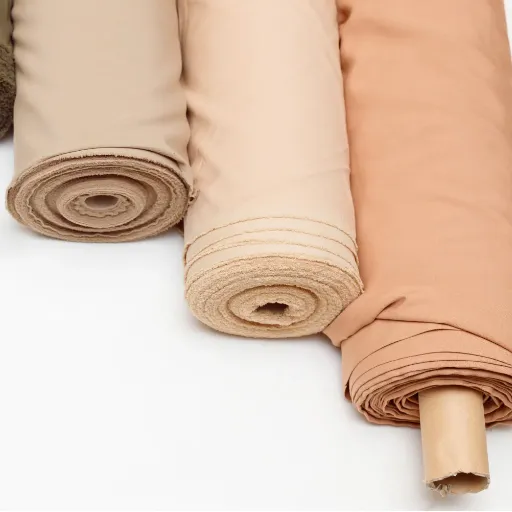
Breathability and Comfort
Cotton fabric is perhaps considered one of the most breathable and comfortable fabrics. The natural fibers of cotton allow for the passage of air, so the material can be worn in warm or humid conditions. It absorbs moisture from the skin, helping keep the skin dry and preventing overheating. This breathability definitely adds up to the comfort of cotton clothing, especially since they are for everyday wear.
The soft feel of cotton also contributes to its comfort. Cotton fibers are soft against the skin and thus suitable for all age groups, including people with sensitive skin. Another advantage of cotton is that it does not irritate people, nor does it retain odors, which is favorable for long-term wear. It is, therefore, an excellent choice for casual wear, sleepwear, and underclothes.
Cotton has many plus points but also a few limitations. Cotton wrinkles easily. One has to be careful to wash and set it out for drying or it might shrink. Considering its comfort and breathability, those factors usually override these minor inconveniences, thus being a first choice for anyone in a position to choose clothing for ease and wearability. Being natural, cotton makes for a versatile and ever-fashionable option in fabric use.
Water Absorption and Moisture Wicking
Cotton is highly absorbent due to the long cellulose fibers, and a lot of water can be retained by them. This feature of cotton could be an advantage for towels and clothing that require good water absorption. On the other hand, cotton is excellent at soaking moisture but does not wick it away fast. When wet, cotton tends to remain damp-wet mething-wet. This is uncomfortable when conditions are humid or when dry weather is actually.
Moisture-wicking is a term used to describe fabric properties that pull sweat and water away from the skin and help in the evaporation of the moisture quickly. By nature, cotton is not a strong moisture-wicking fabric, and its fibers can tend to trap moisture, rather than actively transporting it away from the skin. Click Fabric is blah! So synthetic fabrics are the ones that suit better for the task of moisture management, e.g., athletic wear and outdoor apparel, where staying dry is the primary goal.
Blending is used to address the shortcomings of cotton in moisture wicking. When cotton is blended with synthetic fibers, such as polyester, it increases its capacity to wick moisture while maintaining comfort and breathability. As an intermediate option, they consider the softness and more natural feel of cotton with the performance requirements of active or outdoor use.
Environmental Impact of Cotton
Cotton production stands to exert environmental pressure via high-water usage and pesticide dependency. Cotton cultivation generally constitutes excessive water consumption or, commonly, irrigation-fuelled water consumption, wherein water supply is being depleted in water-stressed regions.
It is further considered to be a highly chemical-intensive material prima: synthetic pesticides and fertilizers in vast quantities are sprayed on the crops to shield and help in the accelerated growth of their yields. Contamination of soil and of any water systems in the vicinity by these chemicals can kill or seriously threaten the very existence of surrounding ecosystems and contribute to one form or the other of biodiversity reduction. Farmers and communities adjoining cotton fields may be at health risks due to prolonged exposure to these chemicals.
Organic farming and water-management methods appear to be some of the accepted remedies to environmental issues. Organic cotton farming limits the application of synthetic chemicals while stressing the maintenance of soil quality and biodiversity. Innovations in micro-irrigation, to name one, because it reuses wastewater and also ensures effective water use, thus creating a smaller water footprint for cotton production. Sustainable practices, then, are increasingly incumbent on the ecological interventions that may be made for cotton.
Cotton vs. Polyester: Comparison and Care
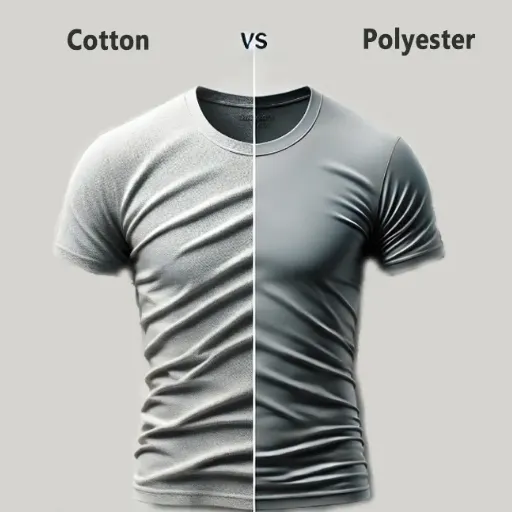
Cotton vs. Polyester
Cotton is natural, breathable, and eco-friendly, while polyester is synthetic, durable, and moisture-resistant.
| Key Points | Cotton | Polyester |
|---|---|---|
| Origin | Natural fiber | Synthetic fiber |
| Breathability | Highly breathable | Less breathable |
| Durability | Moderate | High |
| Moisture-Wicking | Low | High |
| Eco-Friendliness | High | Low |
| Comfort | Soft and gentle | Less soft |
| Wrinkle Resistance | Low | High |
| Cost | Higher | Lower |
| Maintenance | Easy to wash | More resistant |
How to care for and maintain polyester
Polyester is a highly versatile and durable fabric, yet the proper care must be undertaken to retain its quality and increase the life of the garment. Listed below are a few suggestions for better handling of polyester fabrics:
Washing:
- Use cold or warm water (up to 104°F / 40°C) so that the polyester does not shrink or get damaged.
- Choose a mild detergent, as harsher detergents may eventually erode the fibers.
- Machine-wash polyester on a gentle cycle for wear minimization. Do not put too many items in the washing machine to clean properly and avoid creases.
Drying:
- Being quick-drying, air drying is best for polyester. Hang drying helps to avoid wrinkles and retain the shape of the fabric.
- If you must use a dryer, always go with a low heat setting; high heat could damage or melt the polyester since it is heat sensitive. Take the clothing out of the dryer straight after the cycle to prevent it from getting wrinkled.
Ironing:
- Polyester has excellent properties of resistance to wrinkles; however, in case the need for ironing arises, use the setting of low temperature, below 300°F/150°C, with a cloth laid between the iron and the fabric to prevent burning.
- To tackle light, small wrinkles, good steaming can help as well.
Stain Removal:
- Treat stains early by dabbing with water and a mild stain remover.
- Avoid vigorous scrubbing, as this may also weaken the fibers or enlarge the stain area.
Storage:
- Keep polyester in a cool, dry environment to prevent mildew buildup.
- Fold or hang neatly; hang whether it is light or medium weight and very heavy ones should never be kept hanging for long as they might stretch.
Environmental Considerations:
- Being synthetic, they are non-biodegradable and, hence, raise certain environmental concerns. Try washing polyester garments less or using a microfiber filter to cut down on microplastics being released into aquatic streams during each wash.
Since polyester lasts longer and does not wrinkle easily, it is a perfect choice for many types of apparel and home textiles. Polyester items retain their quality and remain usable for many years if these care instructions are followed.
Cotton: Care and Maintenance
Cotton is a natural fiber, much appreciated for its softness, breathability, and comfort; it finds widespread application in textiles. Cotton products should be cared for and maintained properly to ensure that they last well and stay in good condition. Some detailed care instructions are as follows:
Washing:
Most cottons are machine washable; nevertheless, check on garment labels for specific instructions. Wash with cold or warm water to avoid shrinking, and use mild soap to keep the cotton soft. Cotton is established to be one of the few fabrics in which a cold water wash reduces energy consumption to an extent of around 90% as compared to hot water washing.
Drying:
High heat has the tendencytends to cause shrinkage in cotton fabrics. Thus, in order to avoid shrinkage and for that matter environmental consciousness, it is better to consider air-drying your cotton clothes. When using a dryer, always select the low heat setting. High heat settings can cause weakening of the fibers due to over-drying.
Ironing:
Ironing may be necessary for cotton to give it a neatly pressed look. Medium to high heat on the iron, coupled with steam application, is considered best. To prevent permanent marks, ensure the fabric is slightly damp when ironing.
Removal of Stains:
Depending upon what is necessary and how quickly applied, stains can be prevented from setting into cotton fibers. Try staining agents such as stain removers or soaking them in a baking soda grout paste as a natural alternative. The stained area should be gently blotted away and not rubbed, then proceed to wash as usual.
Storing:
Keep cotton fabrics folded in a suitably cool and dry environment so as not to promote mold growth or mildew formation. Hanging cotton will sometimes stretch it under its own weight over a long period of time. Place storage items in breathable bags so as not to retain moisture.
Industry news is abuzz about how, upon mere demonstration of proper cotton care, the life span of garments may be extended by as much as 50%, thereby deterring the buying of a new garment and lessening environmental impact from the production of textiles. As far as the weaving methods are concerned, those would go a long way toward ensuring that cotton articles retain their durability, comfort, and beauty for many years.
Applications of Cotton and Polyester
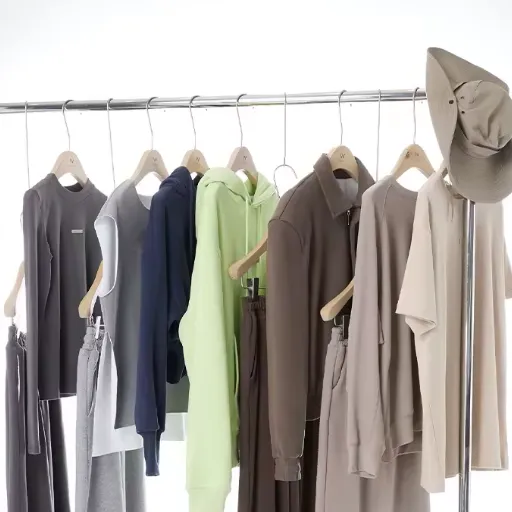
Best Uses for Cotton Fabric
Cotton fabric is one of the best choices being them versatile, comfortable fabric, favored for lay applications. It is breathable and soft and ideal for daily wear such as T-shirts, dresses, and undergarments. Over 50% of the global clothing is made from cotton, according to the textile industry, mainly because it can provide comfort in both hot and cold weather.
Another reason for cotton’s popularity is its good absorption of water in towels, bed sheets, and bathrobes. It can absorb water up to 27 times its own weight, drying sweat quickly while remaining breathable-a crucial attribute of activewear and summer wear.
Among other décor considerations, cotton finds major applications here. From curtains and window treatments to sofa covers, cotton lends lasting durability while maintaining a luxurious yet natural feel. Indoor furnishings made out of cotton fabrics are easy to maintain and hypoallergenic, which is an advantage for people with sensitive skin.
Cotton resorts to industrial uses as well, such as canvas bags or tough uniforms, because of its durability and resistance to wear and tear. Cotton, for being biodegradable, is eco-friendly than a synthetic fabric. With these qualities, the use of cotton stretches one step beyond mere everyday cloth-making to household items and special industrial purposes, further hinting at cotton’s importance in industrial textile production.
Best Uses for Polyester Fabric
Because of the heavy-duty characteristics polymer fabric possesses, it is also known for being versatile and easy care, which makes it an indispensable material in almost all industries. One of the most common uses of this variety of textile is clothes production, especially activewear and outerwear. Shrinking, wrinkling, and stretching are characteristically resisted by polyester, so it remains overtly practical in garments intended to hold their shape and to be frequently used. Moreover, it is also often blended with other fibers, such as cotton, for comfort and performance.
In the domestic arena, polyester holds the second place in demand after clothing. Curtains, upholstery, and even tablecloths are provided with stain-resistant and strong polyester. Additionally, it acts as a substitute for natural fibers to produce home décor items that look nice but are much more robust.
The most important use of polyester in industry is to manufacture conveyor belts, tire reinforcements, and ropes. It has high tensile strength and abrasion resistance, enabling it to be used in the most demanding applications. It means it easily absorbs and then dries quickly, which makes it one of the most versatile synthetic fabrics available in the market.
Cotton and Polyester Blends: The Best of Both Worlds
Cotton-polyester blends share positive traits of each fiber, thus forging fabrics of intermediate durability, comfort, and utility. Cotton provides softness, breathability, and moisture absorption. It is preferred for long wear. Polyester provides strength, resistance to wrinkling, and retention of shape and color through time. When these two are mixed, they complement each other, working through the many shortcomings that each has on its own.
Durability is a major advantage of these blends. Pure cotton fabric may wear thin or shrink upon repeated use and washing, while polyester, with its presence, prolongs the life of the fabric and stands up to wear and tear. The result really makes cotton-polyester blends an ideal choice for workwear, given that textiles are treated with frequent washing or subjected to rough performance.
Cotton-polyester blends, conversely, are low-maintenance and versatile. These blends have a lower chance of wrinkling than pure cotton fabrics and tend to dry quicker; all these make them convenient for busy lives. These blends may be used for a variety of purposes, from casual wear to bedding, to provide comfort and ease. These blends, in a nutshell, are a compromise between strength and softness, invariably winning favor for areas where it is needed.
Frequently Asked Questions (FAQ)
Q: What is the main distinction between cotton and polyester?
A: The main difference between cotton and polyester lies in their origins and characteristics. Cotton is a natural fiber that originates from cotton bolls, while polyester fabric is a synthetic fabric made from polyethylene terephthalate. Cotton is considered breathable, comfortable, and prime for casual wear, whereas polyester is away from cotton with its dense nature, offering durability and wrinkling resistance.
Q: How do cotton and polyester fabrics fare against each other in terms of comfort?
A: Cotton is generally considered to be more comfortable because it is breathable and soft against one’s skin. Polyester, on the other hand, may cause discomfort especially if the person has sensitive skin, for it tends to trap heat and moisture to some extent. When choosing between polyester and cotton, comfort becomes a key factor to be considered.
Q: Is polyester a good fabric choice for activewear?
A: Absolutely. Polyester is widely used for activewear because the fabric can wick moisture and remains quite durable. The synthetic nature of polyester makes the fabric dry very fast and resist shrinking, so it is considered suitable for performance clothing, while cotton absorbs moisture.
Q: What about the environmental impact of cotton versus polyester?
A: Cotton and polyester differ significantly in their environmental impacts. Organic cotton minimizes pesticide use and is biodegradable, whereas conventional cotton production uses a lot of water and chemicals. Polyester, being a synthetic material, is oil-based and hence is problematic to dispose of.
Q: Can cotton and polyester be combined?
A: Yes indeed, cotton can be blended with polyester to obtain the best features from both fibers. Usually, blended cloths have the property of being a little soft and breathable due to a bit of cotton in them while being strong and wrinkle-resistant from the polyester. This blend of cotton is common in a variety of fabric products to help with their performance.
Q: Is cotton more expensive than polyester?
A: Generally cotton is more expensive since it exists in nature and requires farming and kneading. Polyester, being an artificial fiber, is able to be produced at low cost, thereby providing an economical way to be considered when buying various fabric products.
Q: What properties of polyester and cotton are generally considered in the choice of fabrics?
A: The quality of these fibers—polyester and cotton—is primarily vital to fabric selection. Polyester fibers are strong, resistant to shrinking, and fast drying, while cotton is soft, breathable, and natural to wear. Depending on the matter of application, these characteristics can greatly affect the choice of fabric.
Q: What’s better for sensitive skin: cotton or polyester?
A: Generally, cotton is better for sensitive skin since it consists of natural fibers and is breathable. Polyester, on the other hand, may agitate some people, especially when heat or sweat comes into the picture. If cotton or polyester is in question for sensitive skin, then cotton usually would be the safer choice.
Q: What differences exist between the maintenance requirements of cotton and polyester?
A: Being a natural fiber, cotton requires special maintenance care; it may experience shrinkage or fading due to improper washing. Therefore, compared to polyester, cotton would be more inconvenient to maintain. Polyester, by contrast, has a particularly easy-care nature. It is machine washable and wrinkle-resistant.
Q: What are the common uses of cotton and polyester fabrics?
A: Cotton is treated as a fabric for casual outfits, for bed linens, and towels because of its comfort and breathability. Polyester is utilized to a greater extent for activewear, outdoor gear, and upholstery because of its ability to resist abrasion and to wick moisture. Knowing where each fabric finds application helps in making better decisions when it comes to materials.
References
- Polyester vs Cotton – What’s the Difference? – A detailed comparison of the durability, comfort, and uses of both fabrics.
- Polyester Fabric vs Cotton: Differences & 3 Ways to Tell – Highlights the environmental impact, properties, and identification methods for cotton and polyester.
- Polyester vs Cotton: Key Differences – Focuses on moisture absorbency, eco-friendliness, and other key distinctions.
- Cotton Polyester Blend Explained: Pros, Cons, Applications – Explains the properties of cotton-polyester blends and their applications.
- Physicochemical Properties of Cotton and Polyester Textiles – A scientific analysis of the hydrophobicity and water absorption behavior of both materials.









